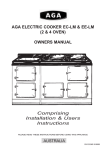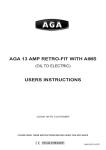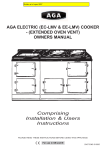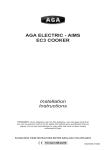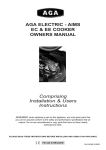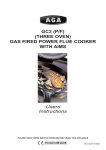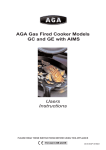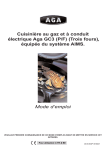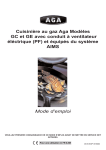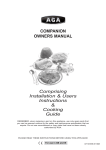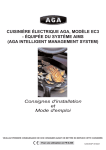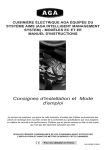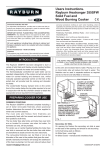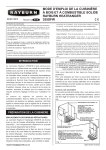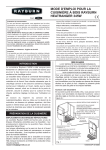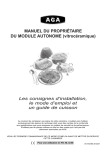Download AGA EC User guide
Transcript
AGA ELECTRIC - AIMS EC & EE COOKER OWNERS MANUAL Comprising Installation & Users Instructions REMEMBER: when replacing a part on this appliance, use only spare parts that you can be assured conform to the safety and performance specification that we require. Do not use reconditioned or copy parts that have not been clearly authorised by Aga. PLEASE READ THESE INSTRUCTIONS BEFORE INSTALLING AND USING THIS APPLIANCE For use in GB and IE 05/09 EINS 515267 CONTENTS SECTION PAGE INSTALLATION SECTION 3 INSTALLATION 3 ELECTRICAL 5 INSTRUCTIONS 6 ELECTRICAL TEST PROCEDURE 6 TO TEST THE AIMS CONTROL HANDSET 7 OVEN THERMOCOUPLE 7 OVEN VENT PIPE CONNECTION OPTIONS 8 OVEN VENTING SYSTEMS 9 - 10 AIMS HANDSET 11 USER GUIDE 12 HEALTH & SAFETY 12 THE AGA COOKER 12 OPERATING THE AGA 13 THE HEAT INDICATOR 14 POWERED OVEN VENTING 14 GUIDE TO AGA COOKING 14 FITTING OF OVEN SHELVES 15 REMOVAL OF OVEN SHELVES 16 AIMS (AGA INTELLIGENT MANAGEMENT SYSTEM) 17 AIMS SET-UP 17 AIMS CONTROLLER HANDSET 17 - 18 INFORMATION (MAIN MENU SCREEN) 19 SETTINGS DATE/TIME SCREEN 19 AIMS PROGRAMME SCREEN 20 HOLIDAY SCREEN 21 AIMS HANDSET CARE 22 CARING AND CLEANING FOR THE AGA 23 SERVICING 23 2 INSTALLATION SECTION Consumer Protection As responsible manufacturers we take care to make sure that our products are designed and constructed to meet the required safety standards when properly installed and used. IMPORTANT NOTICE: PLEASE READ THE ACCOMPANYING WARRANTY Any alteration that is not approved by Aga could invalidate the approval of the appliance, operation of the warranty and could also affect your statutory rights. In the interests of safety and effective use, please read the following before using your new Aga appliance. Important This appliance may contain some of the materials that are indicated. It is the Users/Installers responsibility to ensure that the necessary personal protective clothing is worn when handling, where applicable, the pertinent parts that contain any of the listed materials that could be interpreted as being injurious to health and safety, see below for information. Fire Cement - when handling use disposable gloves. Glues and Sealants - exercise caution - if these are still in liquid form use face mask and disposable gloves. Glass Yarn, Mineral Wool, Insulation Pads - may be harmful if inhaled, may be irritating to skin, eyes, nose and throat. When handling avoid inhaling with skin or eyes. Use disposable gloves, face-masks and eye protection. After handling wash hands and other exposed parts. When disposing of the product, reduce dust with water spray, ensure that parts are securely wrapped. INSTALLATION With specific exceptions, the installing of any type of Aga Cooker is subject to the respective directions contained in current issue of the Building Regulations. In addition, planning permission may need to be obtained, which should be applied for separately. The complete cooker is floor-mounted and the space in which the appliance is to be fitted must have the following minimum dimensions:A 3mm gap is required each side between the cooker top plate and adjoining work surfaces that maybe fitted, this is to allow for the safe removal of the top plate, should this be required at a later date. Where cookers are fitted against side walls which protrude beyond the front of the Aga, a 116mm clearance is required at the RH side for oven doors access. If the Aga is to be installed in a brick recess, then the minimum clearance should be increased by at least 10mm on either side, to allow for the walls not being square and also for the natural dimensional variations found in the castings. In addition, a minimum clearance of 1000mm must be available at the front of the cooker to enable the cooker to be serviced. NOTE: AGA COOKERS ARE DELIVERED EX-WORKS UNASSEMBLED. ASSEMBLY IS UNDERTAKEN BY THE AUTHORISED AGA DISTRIBUTOR/SPECIALIST. Cooker Base or Hearth It is essential that the base or hearth on which the cooker stands should be level and be capable of supporting the total weight of the cooker. Model EC - 406 kg Model EE - 584 kg 3 The top of the hearth must be of non-combustible material thickness of 12mm. The wall behind the cooker must be of non-combustible material for a minimum thickness of 25mm. If the oven vent pipe passes through combustible material, there must be an airgap of at least 25mm around the pipe preferably wrapped with insulation material. The appliance oven venting pipe can be achieved up to a maximum length of 6 metres, through an outside wall or unused flue etc. Great care must be taken in all-timber houses. Tiling When the cooker is to stand in a recess, or against a wall which is to be tiled, in no circumstances should the tiles overlap the cooker top plate. Installation Requirements The installation of the cooker must be in accordance with the relevant requirements of the IEE Wiring Regulations and Building Regulations. It should be in accordance also with any relevant requirements of the local authority. In your own interest, and that of safety to comply with the law, all appliances should be installed by an authorised Aga distributor, in accordance with the relevant regulations. EC-LMV MODEL * THIS HOLE IF REQUIRED FOR OVEN VENT PIPE IS TO BE CUT ON SITE IN THE LEFT OR RIGHT HAND SIDE PANEL. A Fig. 1 B C D F G H mm 987 889 851 679 1330 756 1125 K 3 L M N R T V W X Y Z 698 484 816 116 52 790 873 55 699 662 4 EE-LMV MODEL * THIS HOLE IF REQUIRED FOR OVEN VENT PIPE IS TO BE CUT ON SITE IN THE LEFT OR RIGHT HAND SIDE PANEL. A Fig. 1A B C D F G H mm 1487 889 851 679 1330 756 1125 K L 3 M N R T V W X Y Z 698 484 816 116 52 790 873 55 699 662 ELECTRICAL WARNING: THIS APPLIANCE MUST BE EARTHED. THIS APPLIANCE IS DESIGNED FOR THE VOLTAGE STATED ON THE RATING PLATE, WHICH IS SITUATED BEHIND THE LOWER LEFT HAND DOOR. A 13 amp 230v ~ 50 Hz fused electrical supply is required adjacent to the appliance. External wiring to the unit must be installed using a 3 core silicon - SIHF insulation cable and in accordance with the current wiring regulations and any local regulations which apply. The method of connection to the mains electricity supply must facilitate complete electrical isolation of the appliance, preferably by a fused double pole switch, having a contact separation of at least 3mm in both poles. A 13A safety plug can be used, however, we do strongly recommend connection via a fused double pole switch for integrity of the connection. If a 13A safety plug is used it must be of a high quality and must be to BS1363 - 3: 1995 (13A Plugs, socket, outlets and adaptors). NOTE: Switched spur outlet should only serve the appliance. The isolator should not be positioned immediately above the cooker, but must be fitted within 2 metres of the appliance. 5 INSTRUCTIONS Hand this Owners Manual to the User for retention and instruct in the safe operation of the appliance. Also advise the user that, for continued efficient and safe operation of the appliance that servicing is carried out at intervals recommended by the Aga distributor. ELECTRICAL TEST PROCEDURE Final Electrical Test using (CLARE) and Flash Test Flash Test Procedure (Earth Appliance Test Simulation) 1. Select 1250v Flash Test on Clare Test equipment. 2. Plug the 13 amp supply plug into the test equipment. 3. Depress the red ‘Test Button’ for 3 seconds. 4. A ‘Pass’ light will illuminate. 5. If the appliance fails the test, re-check all circuits and correct the fault and re-test the appliance. 6. Disconnect from the test equipment and connect cooker to its permanent supply. 7. A full load test will be performed using a clamp meter connected to the incoming supply. NOTE: The test results 10.5/11 amps normal operation. 8. Make notes of results and disconnect all leads. Fig. 2 6 TO TEST THE AIMS CONTROL HANDSET DESN 515291 Fig. 3 Press the fan button on the handset, the vent fan symbol should show on the handset screen. The oven vent fan should operate and the fan oven neon on the control panel should illuminate. Press the fan button again and the fan should go off. In the event of the handset not communicating with the base unit refer to page 22 of these instructions “Handset to base unit signal check” OVEN THERMOCOUPLE NOTE: On AIMS controlled cookers the thermostat phial (probe) has been replaced by an oven thermocouple sensor, which is fitted to the PCB on the controls chassis (See Fig. 2). 1. Feed the thermocouple sensor through the guide tube into the Roasting oven. 2. Fit the thermocouple sensor to the support plate so that the sensing tip is as shown in (Fig. 4). DO NOT OVERTIGHTEN the clamp as this may damage the sensor. Screw support plate to top of roasting oven. 3. When assembling the controls chassis to the burner housing:Ensure that the thermocouple sensor goes through the notch in the top rear of the panel, and that the sealed pot is below the notch (i.e. sealed pot must not be trapped between mounting chassis and mesh shield). Fig. 4 DESN 515277 A 7 Fig. 5 DESN 515284 OVEN VENT PIPE CONNECTION OPTIONS Fig. 6 DESN 513987 8 OVEN VENTING SYSTEMS See Figs. 7, 8, 9 & 10 Pre-site visiting will have determined where and how the layout of the oven vent pipework should be designed and installed. It is then necessary to check that the pipework design and the pipework resistance are within the parameters possible. The appliance oven venting pipe can be achieved, up to a maximum length of 6 metres, through an outside wall or unused flue etc. Great care must be taken in all-timber houses. If the oven vent pipe passes through combustible material, there must be an airgap of at least 25mm around the pipe and preferably wrapped with insulation material. Setting the Vent Fan (Motor Speed) Setting of the motor speed is carried out by adjusting the Voltage Regulator (VRI) on the controller PCB in conjunction with a voltmeter. (See Fig. 8). The max supply to the motor, as calculated in Fig. 7, should be limited to 20v (DC), for ideal operating condition. Calculating the voltage for the particular pipework layout is as follows: 1. Keep the pipe run as simple as possible - avoid bends. 2. “Vertical risers” are not permitted. 3. Pipe run should be horizontal - slight downwards slope towards fan. Minimum 12 volts for first metre of vent pipe run inclusive of 1 bend. Each extra metre add 1 volt. Each extra bend add 2 volts. Maximum allowed 20 volts. Alternative Oven Venting Systems Venting may be achieved directly into the flue providing a stabiliser is fitted. See Fig. 8. NOTE: IN THE OVEN VENTING INSTALLATION, WHETHER FAN ASSISTED OR NATURAL FLUE, PROVISION MUST BE MADE FOR EASY ‘RIFLING’ OF THE PIPE WORK TO FACILITATE CLEANING. 9 Fig. 7 Fig. 8 DESN 515276 Fig. 9 DESN 513938 DESN 515431 10 AIMS HANDSET Consumer Protection AIMS HANDSET Handset can be wall mounted as described below. Remove backplate from the rear of the Handset by sliding down with hand and away from the Handset (fig 10). Select the site for the handset and use the backplate to mark the position of fixing holes. Drill 6mm dia. holes with masonry drill for the rawplugs. Use rawplugs and screws supplied to fix the backplate to the wall (fig. 11). Stick the round self adhesive label supplied to the inside of the backplate to cover the fixing screw heads. Fit the Handset on to the backplate by locating the tag on to the slot in backplate as shown (fig. 12). Fig. 10 Fig. 11 Fig. 12 11 USERS GUIDE HEALTH & SAFETY Consumer Protection As responsible manufacturers we take care to make sure that our products are designed and constructed to meet the required safety standards when properly installed and used. This appliance is not intended for use by persons (including children) with reduced physical, sensory or mental capabilities, or lack of experience and knowledge, unless they have been given supervision or instruction concerning use of the appliance by a person responsible for their safety. Children should be supervised to ensure that they do not play with the appliance. IMPORTANT NOTICE: PLEASE READ THE ACCOMPANYING WARRANTY. Any alteration that is not approved by Aga could invalidate the approval of the appliance, operation of the warranty and could also affect your statutory rights. APPLIANCE YOUNG CHILDREN SHOULD BE KEPT AWAY FROM THE APPLIANCE AS SURFACES CAN BECOME HOT TO THE TOUCH. Deep Fat Frying IMPORTANT z Use a deep pan. z Never fill the pan more than one-third full of fat or oil. z Never use a lid on the pan. z Important: Oil is a fire risk, do not leave pans containing oil unattended. z In the event of a fire, cover the pan with a lid and turn OFF the appliance. Smother the flames on the hob preferably with a fire blanket, rather than attempting to remove the pan to the outside. Burns and injuries are caused almost invariably by picking up the burning pan to carry it outside. THE AGA COOKER The appliance is a heat storage cooker with a 13 amp element which will keep the temperature of the cooker constant when not in use and return it to constant temperature after use, or in accordance with preset AIMS programme. The Aga is also supplied with the following accessories: 1 Large roasting tin with grill rack 1 Half size roasting tin with grill rack 2 Oven grid shelves 1 Plain shelf 1 Toaster 1 Aga book 1 Wire brush Samples of enamel and chrome/stainless cleaner A full description of cooking with the Aga is given in the Aga book. 12 Fig. 13 DESN 513946 OPERATING THE AGA The following points are intended to help during the period of change-over from a previous cooker. The Aga book and the new user guide video provide a very useful introduction to the cooker. After the Aga has been assembled When first used the Aga will emit an odour for a short while. This is simply due to the protective oil burning off the hotplates. Wipe the inside of the lids whilst the Aga is heating up to avoid a film of oil being deposited on the inside of the lids. Also, condensation may occur on the top plate and front plate whilst the Aga is heating up. This should be wiped away as soon as possible. For most effective operation of the cooker the following points should be carefully observed: 1. 2. 3. 4. 5. 6. Close the insulating covers whenever the hotplates are not in use. Clean the hotplates regularly with the wire brush. Utensils with ground flat bases must be used to make perfect contact with the hotplates. Have the cooker serviced at regular intervals by your Aga Specialist. Take care, when closing the oven doors, to left them on to the catch. Cook as much as possible in the ovens, so that heat is conserved and cooking smells and condensation are reduced. The Roasting Oven can also be used for ‘grilling’ at the top and shallow ‘frying’ on the oven floor. Keep the insulated covers down when the hotplates are not in use so that the heat stored in the cooker is conserved. z For optimum cooking performance, use the Aga utensils and cast iron cookware. They have thick ground bases which give the best contact with the hotplates. z The Aga pans can be stacked in the Simmering Oven. This is especially useful for steaming vegetables and keeping sauces warm. z Store the Plain Shelf out of the Aga. Use it cold in the Roasting Oven to deflect the heat from the top of the oven, creating a more moderate oven temperature underneath. It can also be used as a baking sheet. z A guide to Aga cooking is given on Page 14. Ask the Aga Specialist for an invitation to an Aga demonstration. 13 THE HEAT INDICATOR BLACK too low SILVER RED BLACK LINE correct amount of stored heat too high The heat indicator is above the Roasting Oven door and has three sections: black, silver and red. When the indicator is on or about the black line in the silver section the cooker is at the correct working temperature. The purpose of the heat indicator is to show whether or not the cooker contains the full amount of stored heat when the cooker is in its normal operational mode. During cooking the indicator line will drop back. This is normal and the heat will be automatically restored. NOTE: IT DOES NOT INDICATE OVEN TEMPERATURE. POWERED OVEN-VENTING Roasting and Simmering Ovens This feature is fitted to your cooker, it should be used as follows: After placing the food to be cooked in the oven, depress the switch on the remote control, a light will appear behind the bottom left hand door, the fan will be activated and the cooking smells will be vented to outside. (Refer to Fig. 15) REMEMBER: SWITCH THE FAN OFF WHEN YOU HAVE FINISHED COOKING. GUIDE TO AGA COOKING As the Aga Cooker is heated differently from an ordinary cooker, exact conversions are not possible. Look in the Aga Book for a similar recipe. Below is a quick guide to oven usage. OVEN TEMPERATURE 2=TWO OVEN AGA =4=FOUR OVEN AGA HIGH ROASTING OVEN ROASTING OVEN GRILLING SCONES PASTRIES BREAD YORKSHIRE PUDDING ROASTS SHALLOW FRYING Top - grilling; 2nd runner - scones, small pastries; 3rd runner - bread rolls, Yorkshire pudding; 4the runner - roasts, poultry, small cakes in cases in the large meat tin. Grid shelf on oven floor - loaves. Oven floor - shallow frying. quiche. Top - grilling; 2nd runner - scones, small pastries; 3rd runner - bread rolls, Yorkshire pudding; 4the Runner - troasts, poultry. Grid shelf on oven floor - loaves Oven floor - shallow frying, quiche. MODERATE ROASTING/SIMMERING OVEN BAKING OVEN CAKES BISCUITS FISH SOUFFLÉS SHORTBREAD CHEESECAKES Place grid shelf on floor of Roasting Oven. Protect food with the cold plain shelf slid on second or third runners. For cakes that require over 45 mins use the Cake Baker. Alternatively with fish, cheesecake, start off in Roasting Oven, finish in Simmering Oven. Towards top - whisked sponges, some biscuits, small cakes Middle - fish, soufflés Grid shelf on oven floor - Victoria sandwiches, shortbread and cheesecake LOW SIMMERING OVEN SIMMERING OVEN CASSEROLES STOCK MILK PUDDINGS MERINGUES RICH FRUIT CAKE For Casseroles, stock, milk puddings, bring to heat elsewhere on the Aga then transfer to Simmering Oven. (One exception is meringues). Rich fruit cakes can be cooked for a long time here For casseroles, stock, milk puddings, bring to heat elsewhere on the Aga then transfer to Simmering Oven. (One exception is meringues). Rich fruit cakes can be cooked for a long time here. 14 FITTING OF OVEN SHELVES When using the oven shelves for the first time follow Figs. 14a - 14d. Fig. 14a DESN 512403 Fig. 14b DESN 512404 15 REMOVAL OF OVEN SHELVES Fig. 14c DESN 512405 Fig. 14d DESN 512406 16 AIMS (AGA INTELLIGENT MANAGEMENT SYSTEM) CONTROLS Fig. 15 DESN 515283 AIMS SET-UP (SEE FIG. 15) 1. Connect the electricity supply. 2. Turn the right hand control knob from the OFF setting to the normal manual control setting. The cooker will heat up until it reaches the normal temperature as indicated by the black line on the heat indicator. 3. The left hand control knob will alter the oven temperature. Turn it clockwise to increase the temperature and anticlockwise to decrease the temperature. To obtain the required roasting oven temperature of 240°C this control knob will need to be set about halfway. We recommend that the cooker is run on the Normal manual setting for two days, before switching to AIMS (automatic control). 4. When the normal temperature has been set with heat indicator on or near the black line, it should not be necessary to alter the temperature control again. 5. The cooker can now be switched to AIMS (automatic control), by turning the right hand control knob from the setting to the AIMS setting. 6. The AIMS hand set can then be used to programme the required settings (see AIMS (automatic) control instructions. AIMS CONTROLLER HANDSET This handset is designed to operate within the kitchen area. When transferring information from or to the controller always operate the handset in front of the cooker, this gives the strongest communication signal. If the handset indicates ‘OFFLINE’, press the BACK between the cooker and handset. button firmly, this will activate the communication link Should the handset continue to show ‘OFFLINE’, allow one minute for the handset to automatically reconnect itself with the cooker. 17 Fig. 16 DESN 515271 The handset has 10 buttons and a display screen. NOTE: If the AIMS handset is unused for an extended period of time, the display screen will automatically turn OFF to conserve battery power. The controller is designed to be operated within the kitchen area. Press firmly any button on the handset to turn the display back on, and the Information (main menu) screen is automatically displayed. The AIMS Controller handset has four display screens: 1. The Information (main menu) screen 2. The Date/Time setting screen 3. The AIMS Programme screen 4. The Holiday Setting screen See each section for details. The AIMS has one or two programmable events: The two events programme will enable the Aga to be at ‘Normal’ in the morning, (ie to cook breakfast) drop to a lower temperature during the day, and return to ‘Normal’ temperature in the evening (ie: to cook dinner) and drop to ‘Slumber’ later in the evening and throughout the night. The one event programme will enable the Aga to drop to ‘Slumber’ during the night and return to ‘Normal’ throughout the day. This will be shown as Once or Twice on the AIMS programme screen. (See Fig. 19). The ‘Normal’ temperature for those two events can be set using the cooker thermostat. The modes in between the events can be set at ‘Low’ or ‘Slumber’ depending on personal preference. If a mistake is made when setting the date or time on any of the screens, use the back button setting. When the oven vent fan button to go back to previous is pressed the oven vent fan will be switched on and a blue light will appear. Selecting Handset Language Language options are selected during the Handset to Base Unit Signal Check/Language Selection procedure, see page 22. 18 INFORMATION (MAIN MENU) SCREEN Press the button to activate this screen This indicates the current cooker mode (Normal, Low or Slumber). If an arrow is showing ; this indicates the cooker is heating up from Low or Slumber to reach Normal Indicates that the cooker is operating automatically (AIMS) or manually (according to switch position on main Aga control panel) Icons indicating the current time and day This will only show if the Holiday mode has been set This icon shows if the vent fan is on or off DESN 515272 Fig. 17 THE SETTINGS DATE/TIME SCREEN Press the button to activate this screen 1. Press the button to move between the date and time. 2. Press + or - to alter date and time settings. 3. Press the button to confirm the settings and move to the next action 1 2 Fig. 18 DESN 515273 19 AIMS PROGRAMME SCREEN Use the button to activate this screen and to move through the different actions and set an AIMS programme. To go back a step at any time press . 1. Set the frequency of the programme Once or Twice daily using + and - buttons. 2. Press button to select start time for ‘Normal’ setting then use the + or - buttons to set start time. 3. Press the button to select finish time then use + and - buttons to set finish time. When a time is selected it will be highlighted in dark blue. 4. Press the button then press the button to alter the temperature setting to ‘Low’, ‘Slumber’, or ‘Off’. (Repeat steps 2 - 4 to set a 2nd event) To copy this days settings for the next day press the button or alternatively press the button to enter different settings for next day. Each push of the copy button steps onto next day. When the desired days have been programmed a return must be made to the main menu screen by pressing the button. A ‘Please Wait’ message will display to confirm changes are being sent to the base unit. If the programme is not set for the whole week the programme for the remaining days will revert to a default setting. ie: 8:00 am - 9:00 am and 18:00 - 19:00. To change a setting within the AIMS program, press the button until the desired setting is reached. Then change setting using either the +, - or buttons as appropriate. If no other changes are to be made, push the button to transmit the change (s) and return to main menu. A message saying ‘Please Wait’ will display, indicating that the changes are being transmitted to the base unit. Unless this shows, the changes will not have been implemented. 1 3 2 4 3 2 4 Fig. 192 DESN 515274 This screen shows that the ovens will be up at ‘Normal’ temperature between 07:00 and 10:00, the ovens will then go to ‘Low’ mode. The ovens will come up to ‘Normal’ once more in that day i.e. at 16:00 until 19:00. After the evening, the system will automatically enter ‘Slumber’ mode, its lowest setting until the next morning. Boost If cooking is required when the Aga is in the AIMS program i.e ‘Low’ or ‘Slumber’, you can boost the cooking temperature by pressing the Button which will bring the Aga upto ‘Normal’ operating temperature. This will take up to 2 hours from ‘Low’ and 4 hours from ‘Slumber’. 20 THE HOLIDAY SCREEN Press the programme. button to activate this screen and to move through the different operations and set a holiday 1. Set a start date and time using the + or - buttons. Pressing the button after each field has been entered to move you to the next field. When a field is selected it will be highlighted in dark blue. 2. Set an end date and time using the + or - buttons. Pressing the button after each field has been entered to move you to the next field. 3. Press the button to alter the temperature setting to ‘Low’, ‘Slumber’ or ‘Off’ When all the settings are completed press the button again to enable the Holiday programme. The display will return to the Main Menu Screen. 3 2 1 Fig. 20 DESN 515275 Once a holiday mode has been set it will show as ‘Holiday Enabled’ on the main menu screen. If you wish to cancel the holiday setting: Press the button, then press the button and the following screen will appear: Cancel Holiday? Yes Select YES using the button, then return to main menu screen. No If you wish to alter a holiday setting:Press , alter setting (use + or - then ), then after last setting press again to return to main menu screen. In event of a power cut If mains power is lost/or disconnected for more than 15 minutes, when the power is restored the handset will display:- Power Cut By then pressing the to the base. OK 21 button, this will send the correct time/date settings AIMS HANDSET CARE Operating Distance The Handset will only operate in the same room as the appliance and up to a maximum distance of 4 metres from the appliance. If out of recommended operating range, the handset may show “OFFLINE”. Move handset back to within the recommended distance and the handset should correct itself. See note at foot of page for “Handset to Base Unit Signal Check”. Cleaning The Handset should be wiped clean using a soft clean cloth. Do not use abrasive cleaning products or submerge the Handset in water. Batteries The Handset is fitted with four 'AAA' batteries. Batteries life will depend on usages. Replace the batteries when the battery symbol on the Handset is down to one bar following the instructions below. - Remove the Handset from the backplate. - Remove the battery cover plate from the rear of the Handset (fig 21) - Carefully lever out the batteries commencing with the bottom one first pushing and pulling out on the positive (+) end only (fig 22). - Repeat the procedure to remove the other batteries. - Always use long life batteries for replacements. - Replace batteries commencing with the bottom one working to the top (fig 23) Ensure that the negative (-) end of the batteries is under the location pegs in the housing before pushing the other end into position. Fig. 21 Fig. 22 Fig. 23 Handset Failure In the event of Handset failure, the appliance would still be operational with the last selected programme. The appliance can also be changed to manual mode if required using the control knob (see fig 15). If the Handset is damaged or lost, replacement can be obtained from Aga and re-programmed to suit your appliance. Handset to Base Unit Signal Check/Language Selection Complete the following procedure to check the handset is communicating with the base unit and to select a language option. 1. Press and hold the oven vent fan button on the control panel in the Aga until the blue neon vent fan indicator flashes, then release button. 2. Immediately after neon starts to flash press and hold the + and - buttons together on the handset until the blue neon goes out completely (handset display will briefly say connect), then release buttons. 3. If the neon does not extinguish completely, but continues to flash with a faint output, then repeat steps 1 and 2 above. 4. When the connection has been made, the screen will display the language options, use the + or - buttons to scroll through the options to the desired language, then press the button to confirm selection. 5. If the language options needs to be changed at any time then the whole procedure must be repeated from step 1. 22 CARING AND CLEANING FOR THE AGA REMEMBER: BE CAREFUL OF THE HOT APPLIANCE. DO NOT A STEAM CLEANER TO CLEAN THIS COOKER. DO NOT USE ABRASIVE PADS OR OVEN CLEANER Top Plate and Front Plate The easiest way to clean the Aga top plate and front plate is to mop up spills as they happen. Baked-on food is more difficult to clean but can usually be removed with Aga vitreous enamel cleaner or mild cream cleaners using a cloth, or, if necessary, a nylon scouring pad. If milk or fruit juice or anything containing acid, is spilt on the Aga, wipe it up immediately. Also clean off any condensation streaks on the front plate around the oven doors or the vitreous enamel may be permanently discoloured. All that is usually needed to keep the vitreous enamelled surfaces of the Aga bright and clean is a daily rub over with a damp soapy cloth followed immediately with a clean, dry cloth to avoid streaks.Remember the top plate and the stainless lids will scratch if pans or utensils are dragged across them. Insulating Lids and Oven Doors The linings of the insulating lids and oven doors may be cleaned with a cream cleanser or a soap impregnated pad. Open the lids and lift off the oven doors to allow them to cool and little before cleaning. Do not, however, immerse the doors in water as they are packed with insulating material which will be damaged by excessive moisture. Refer also to the Cleaning section in the Aga book. Ovens and Hotplates The cast iron ovens help to keep themselves clean, they merely need to be brushed out occasionally with a long-handled stiff brush. The simmering oven may be cleaned with a damp soapy cloth. The wire brush is provided for cleaning the hotplate and any burnt-on spills in the cast iron ovens. DO NOT USE ANY OVEN CLEANERS. Roasting Tins The roasting tins should be cleaned in hot soapy water, soaking if necessary. A nylon scouring pad can also be used. DO NOT place in the dishwasher or use other caustic cleaners. Important: Aga recommend Vitreous Enamel Association approved cleaners for cleaning the vitreous enamelled surfaces of this product, but they are unsuitable for use on: chrome and stainless steel components, including the insulating covers, hand-rails and their brackets. The insulating covers should be cleaned regularly with a NON-ABRASIVE mild detergent, applied with a soft (coarse free) cloth and lightly polished up afterwards with a soft (coarse free) duster or tissue, to bring them back to their original lustre. SERVICING For continued efficient and safe operation of the appliance it is important that servicing checks are carried out at intervals recommended by your authorised Aga specialist. 23 For further advice or information contact your local Aga Specialist With Aga's policy of continuous product improvement, the Company reserves the right to change specifications and make modifications to the appliance described and illustrated at any time. Manufactured by Aga Station Road Ketley Telford Shropshire TF1 5AQ England www.aga-web.co.uk www.agacookshop.co.uk www.agalinks.com 24
























